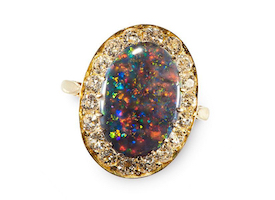
NEW YORK – Opals have been the gemstones of kings for centuries. When worn in bright sun or clear light, opals blaze forth with a seemingly magical display of light and color that is like nothing else. Every opal is more than a piece of polished rock; it’s a radiant experience in which its blues, greens, whites and even black natural colorings is measured by its dazzle and sparkle.
The world of opals (a word derived from the ancient Greek opallios, meaning ‘to see a change in color’) encompasses two types: common and precious. An individual opal’s play-of-color, or lack of color, determines its classification and its rarity at auction. The Hudson Institute of Mineralogy defines play-of-color as “a pseudochromatic optical effect resulting in flashes of colored light from certain minerals … as they are turned in white light.” You see the color variants because the stone diffracts light, a process that bends light around an internal structure, creating the stone’s bewitching iridescence. The more translucent the color, the more iridescent – and thus, the more precious – the stone.

The most precious opals possess a deep black background. These very dark opals highlight the glow of colorful iridescence that plainer opals simply cannot match. Boulder black opals feature more ironstone in their backgrounds and less of the opal itself, reducing their appeal.

Opals are found and mined all around the world, but South Australia is the leading producer, accounting for about 95% of the world’s total production of precious opals. For obvious reasons, Australians have named it their national gemstone.

When an opal lacks iridescence, it is considered a common opal. The milk or white opal, for example, is more opaque than its flashier counterparts, and the iridescence is notably absent. White opals can still put on a heck of a show, however, with blues, greens, reds and yellows scattered throughout, and if cut properly, they can yield a remarkable and worthy gem.

White and sky-blue milky opals were precisely cut and puzzle-set to create these bold 14K gold cufflinks that rock legend Elvis Presley gave to his manager, the notorious Col. Tom Parker. They went for $7,500 plus the buyer’s premium in August 2022. Image courtesy of GWS Auctions, Ltd. and LiveAuctioneers.
An opal can be graded as colorless, crystal, or translucent, such as with Muller’s glass opals, yet still have some radiance of color, especially those found near hot springs, geysers, and silica deposits called diatomaceous earth. Bright red opals, known as Mexican fire opals, can be transparent to translucent depending on whether there is any noticeable play-of-color, but most just display a diffusion of opaque yellow, orange, green and red hues.

The first rule of choosing an opal is to acquire one that makes you happy, but you should also ensure that it works with the jewelry design of your choice. An opal set in a ring or bracelet shouldn’t be too large, or it may wear down as time passes. Those showcased in a brooch or a necklace can be larger.

Opals are a hydrated form of silica, which means they are inherently soft. They rate 6.5 on the Mohs scale and water can account for 5% to 20% of their weight, depending on their source. For that reason, opals should not be worn in very hot and dry conditions for long periods of time. Nor should an opal be exposed to very low humidity, as the water in the stone can eventually evaporate and cause it to crack. Consistently exposing an opal to water can cause it to become cloudy, a characteristic that will affect its value.

If you’re looking for an investment-grade opal, gemologists suggest targeting stones with strong play-of-color. Opals that have a black background with red iridescence are the most valuable, with orange, yellow, green and blue as the next most-valuable colors, in that order. Natural opals will have at least some variations in color, formations and inclusions. Be sure to inspect the stone when it’s dry and hold it near bright light to determine whether it has sustained unnatural cracks from dryness and extended wear. Once an opal is cracked, its value is drastically reduced.
Also, be aware that precious opals can be created in a laboratory setting. Synthetic or simulated opals (the words are used interchangeably) aren’t as sensitive to extremes as natural opals and can be hardened against the effects of everyday wear, which can be an important consideration for some, although, unsurprisingly, their value at auction is limited.
Prior to the major discovery of opal mines in Australia in the late 19th century, opals were considered rare and mined mainly in modern-day Slovakia and Mexico. Opals mined before 1900 are scarcer at auction. Only royalty and the wealthy had access to these pre-20th-century opals, so their settings will be more elaborate.

Pliny the Elder called opals “ … the most difficult to describe, since it displays at one time the piercing fire of carbuncle (ruby), the purple brilliance of amethyst and the green of emerald, blended together and refulgent with an incredible brightness.” This quality – delivering on an all-in-one deal – handily explains why the stone was so highly prized, and remains so. Even now, the opal is seen as a spectacular blend of every other jewel as seen through its kaleidoscope of color. Who wouldn’t want to pluck a piece of a rainbow, hold it and marvel at it, and harness its beauty? Opals, alone among the gemstones, fulfill this promise.


